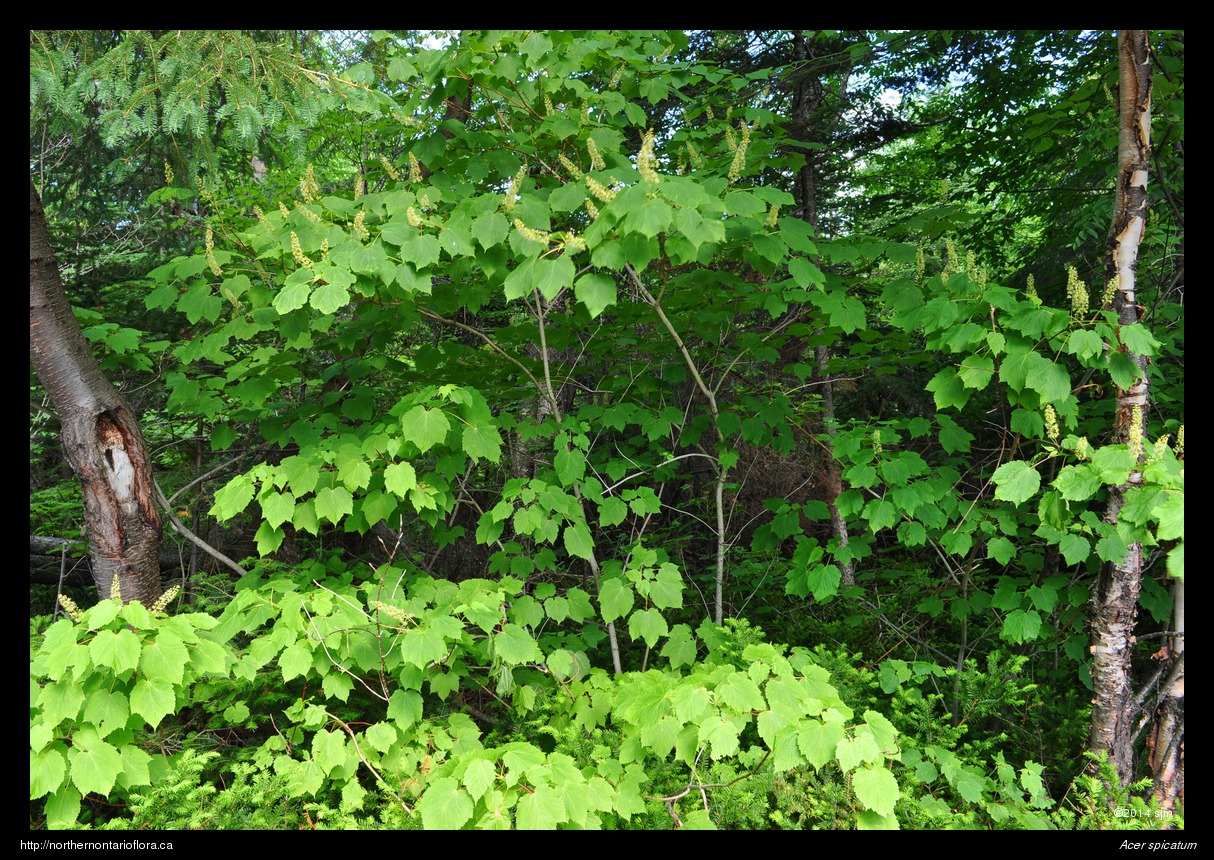
|
Northern Ontario Plant Database 
Plant DescriptionAcer spicatum Lam.En: mountain maple
Sapindaceae (Soapberry Family) General: A tall shrub to short deciduous tree, to 5 m tall; a shade tolerant and shallow-rooted understorey species. Mountain maple provides browse for wildlife; its wood is not used commercially. Stems/twigs: Twigs and buds are finely hairy and olive green, greenish-brown, reddish-brown, or red. The terminal and opposite lateral buds are stalked, ellipsoid, and pointed (acute), with 2 valvate bud scales; leaf scars are broadly V- to U-shaped with 3 bundle trace scars. The bark is reddish brown to grayish brown and smooth (glabrous), mature stems have shallow-furrowed bark. Leaves: Opposite, simple, palmately lobed and veined, and petiolate; the long petioles are often red. Leaves are broadly ovate to orbicular, 6-12 cm long, with 3 short triangular lobes that taper gradually to a pointed (acute to acuminate) apex; a pair of smaller lobes may be present toward the leaf base. The angle between the central and lateral lobes is broad V-shaped (>90°). Leaf blades are glabrous, yellow-green to dark green, and coarse-textured (rugose) above, paler and finely hairy beneath; bases are cordate; margins are coarsely toothed (serrate). Leaves turn orange to bright red in fall. Flowers: Mainly unisexual, with male and female flowers on the same plant (monoecious). Flowers are arranged in terminal erect branched inflorescences (panicles), 3-8 cm long. The central axis (rachis) of the inflorescence and flower stalks (pedicels) are finely hairy. Flowers to 1 cm across; sepals 5, yellowish-green, narrowly oblong, 1-2 mm long; petals 5, white, oblanceolate, 3-5 mm long. Male flowers have 8 stamens attached to the outside of a central nectar disk; female flowers have a superior ovary with 2 winged carpels and 2 styles. Flowers bloom after the leaves have emerged. Fruit: Pairs of winged samaras (maple keys) in pendant clusters, attached to central axis (rachis). Each samara is 1.5-2.5 cm long; the obovate wings are divergent to downward-pointing; the narrow angle between the two wings is <90°. The surface of the seed case is veiny and indented on one side, rounded on the other side. Immature samaras may be yellow, green, pinkish, or red; becoming brown at maturity in late summer. Habitat & Range: Moist shaded rocky slopes, streambanks, and ravines in mixedwood and coniferous forest understories; often forming thickets. Mountain maple occurs throughout the Algoma District and across the southern half of northern Ontario, as well as throughout eastern and southern Ontario. Its range extends from Newfoundland to central Saskatchewan. Similar Species: Striped maple (Acer pensylvanicum L.) is most similar to mountain maple; both typically have 3 triangular lobes that taper gradually to the apex. The buds of striped maple also have 2 valvate bud scales, but their twigs and buds are glabrous. The showy yellow-green to yellow flowers of striped maple occur in pendant clusters (racemes). The bark of striped maple is glabrous, green, and conspicuously striped. Other native maple species in Algoma are seldom shrubby and have buds with several overlapping (imbricate) bud scales. Back to species list |
||||||||||||||||||||||






















